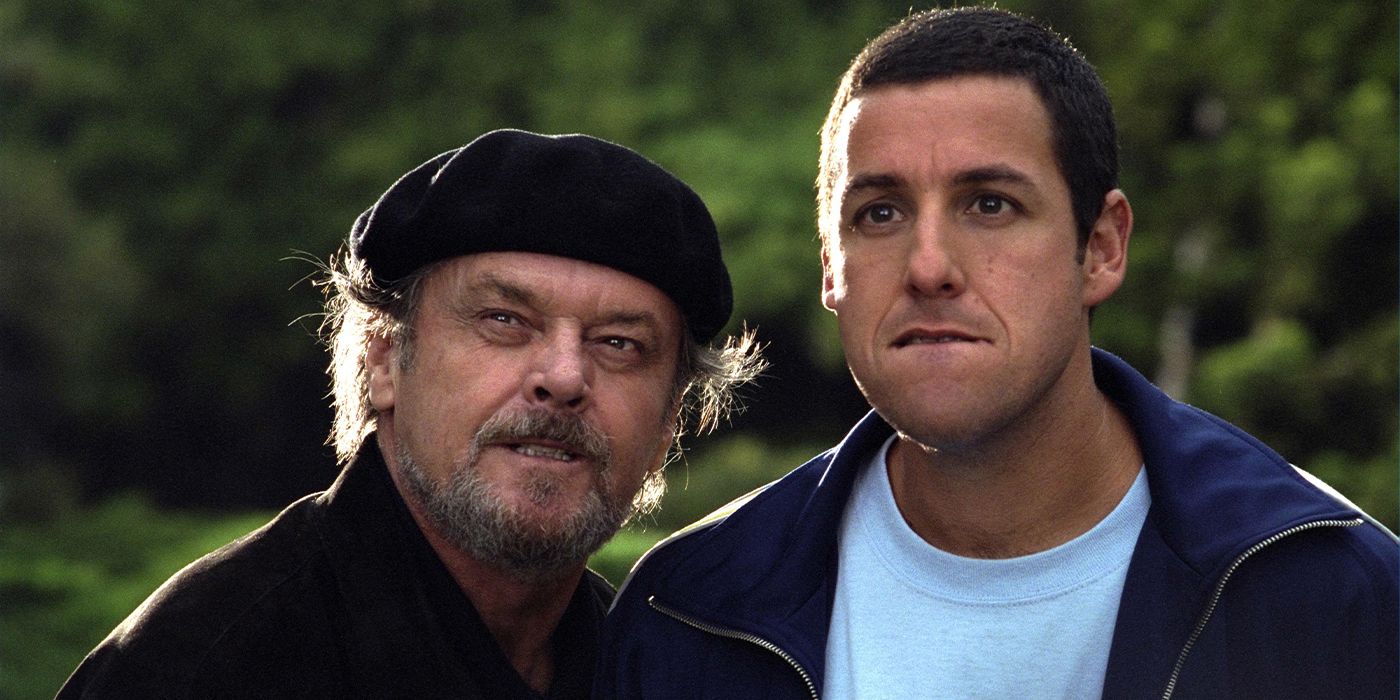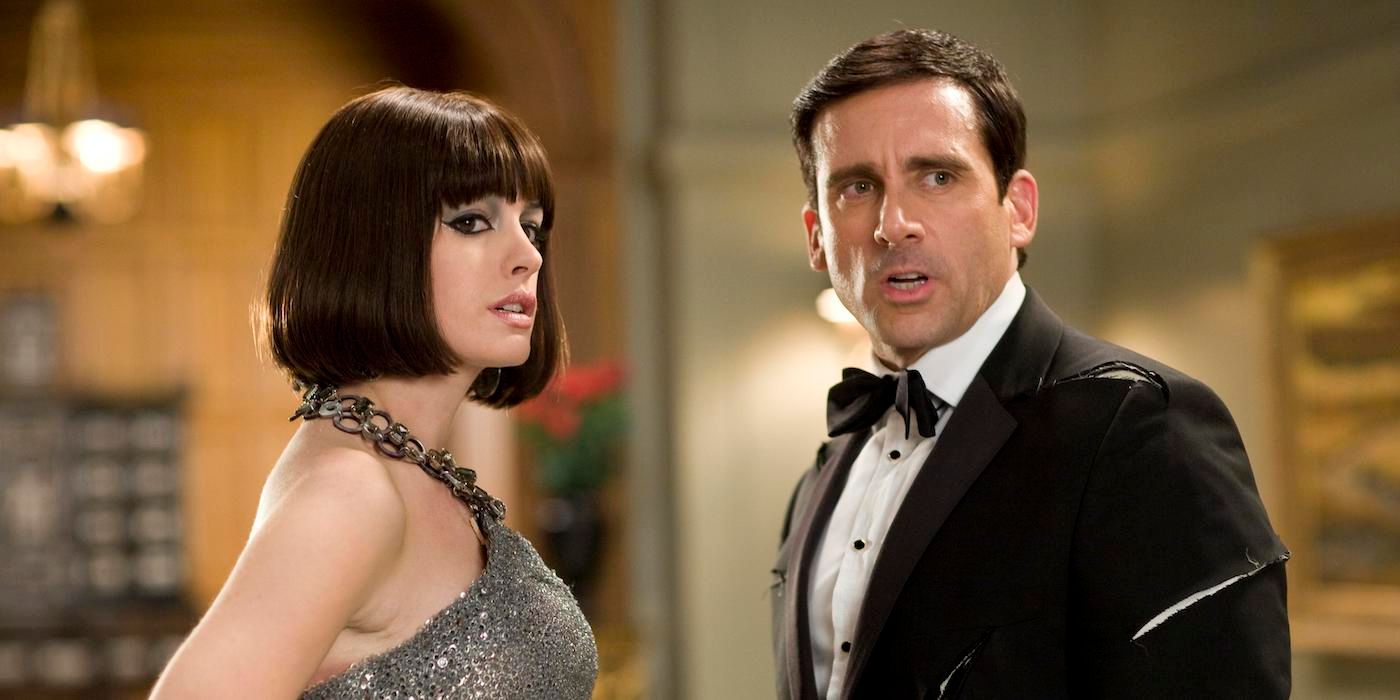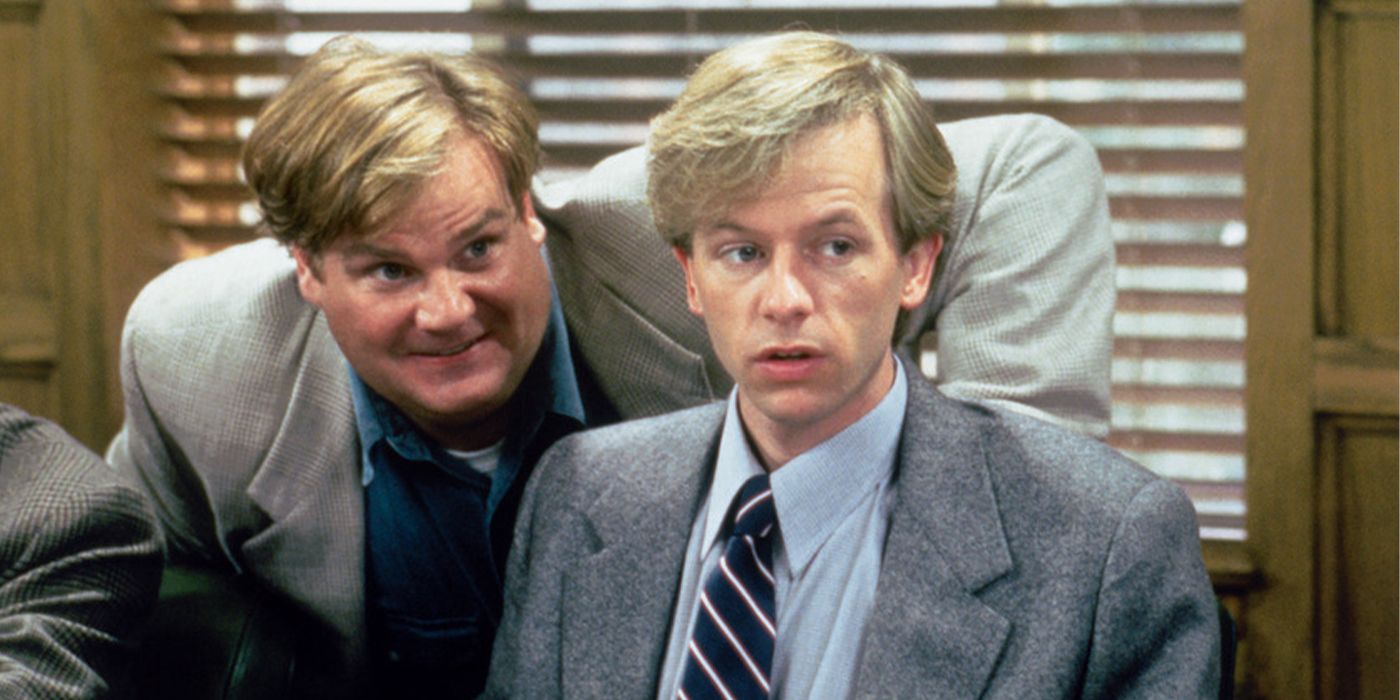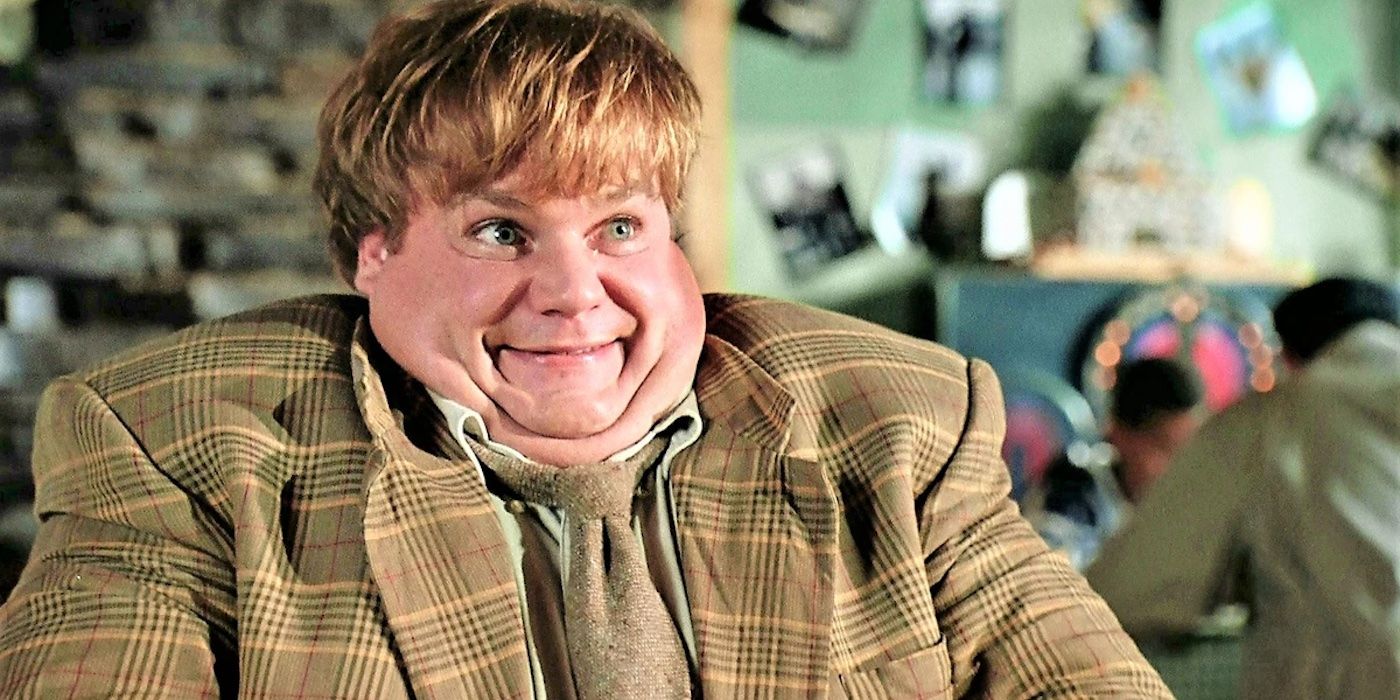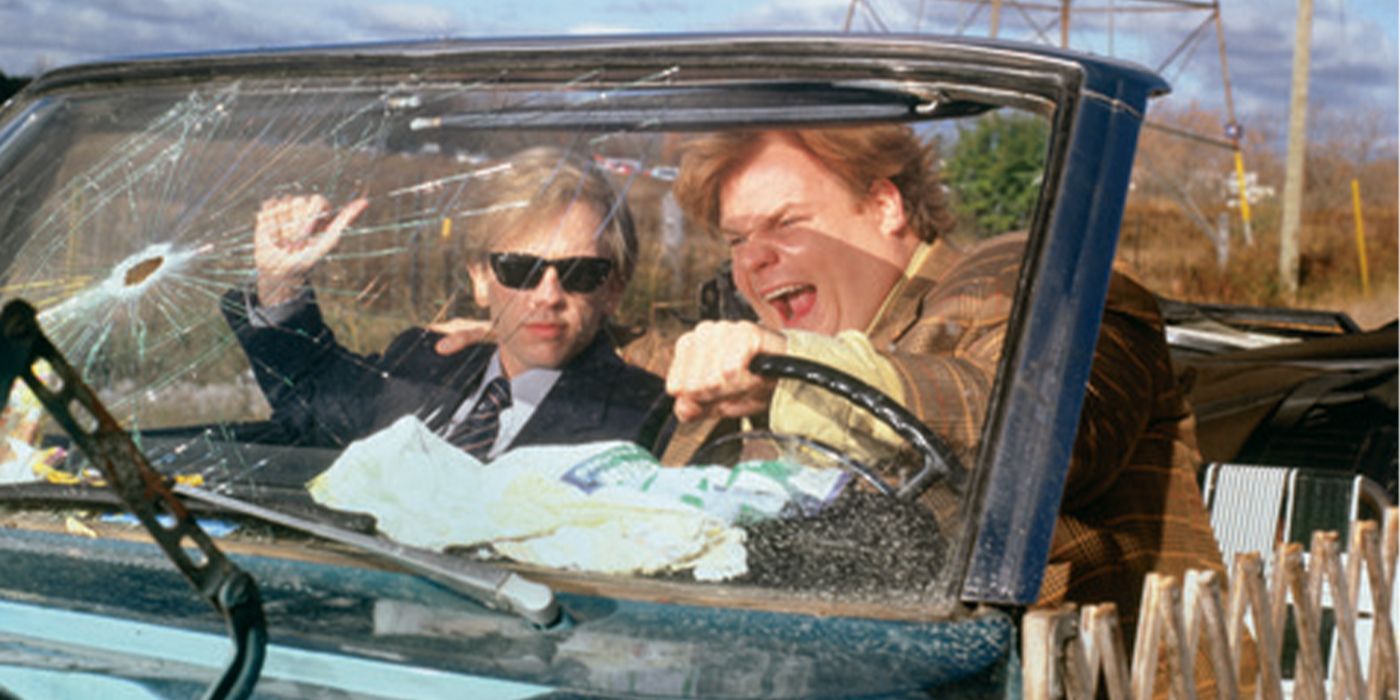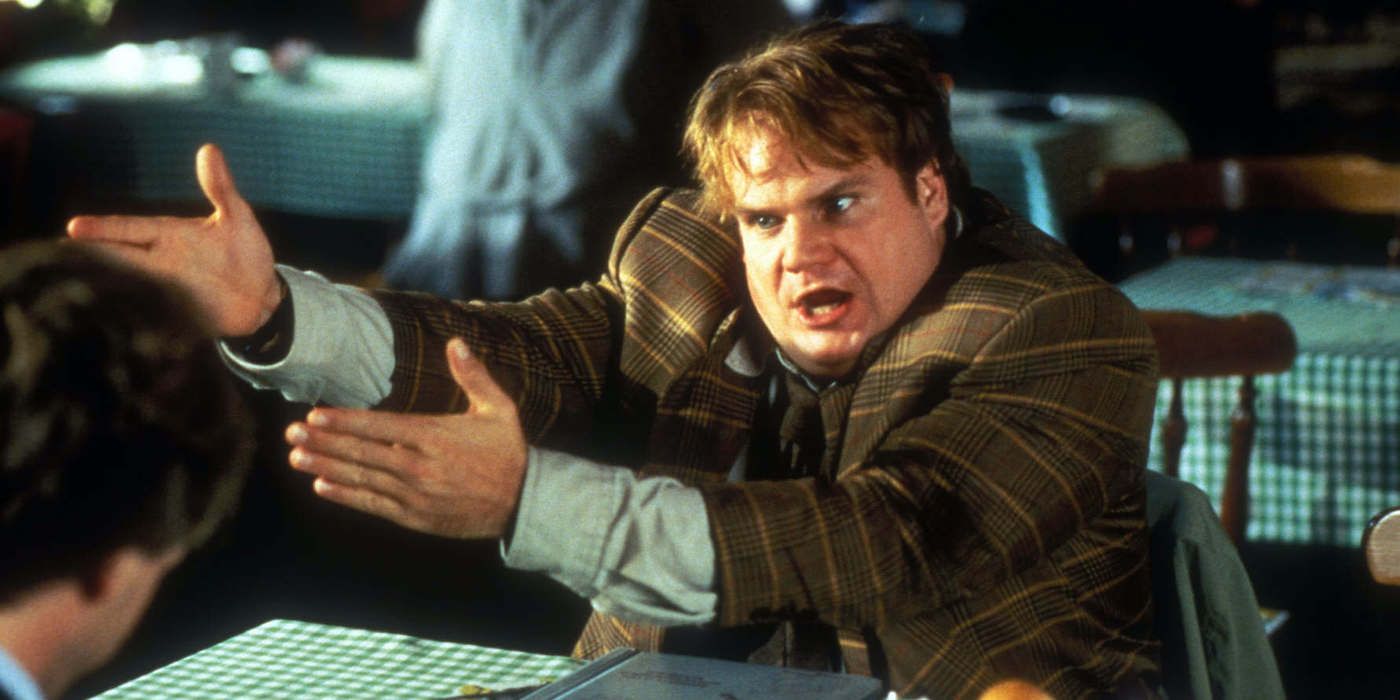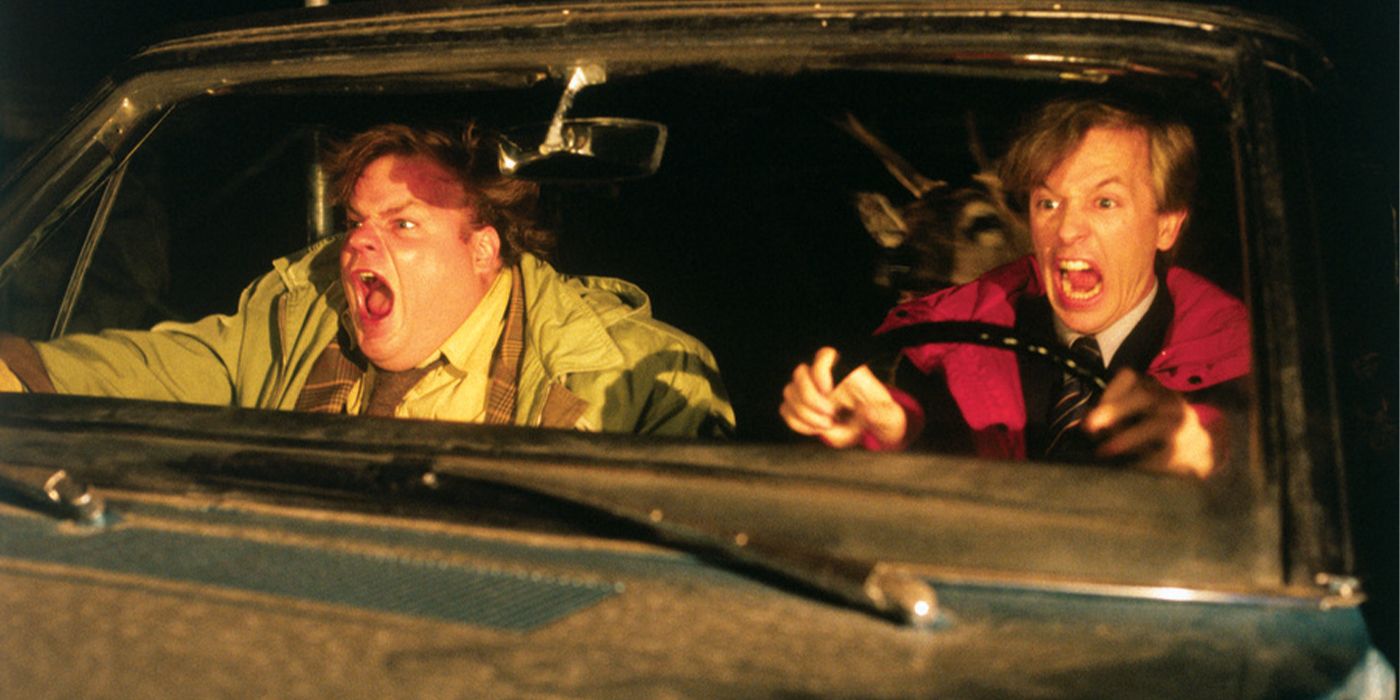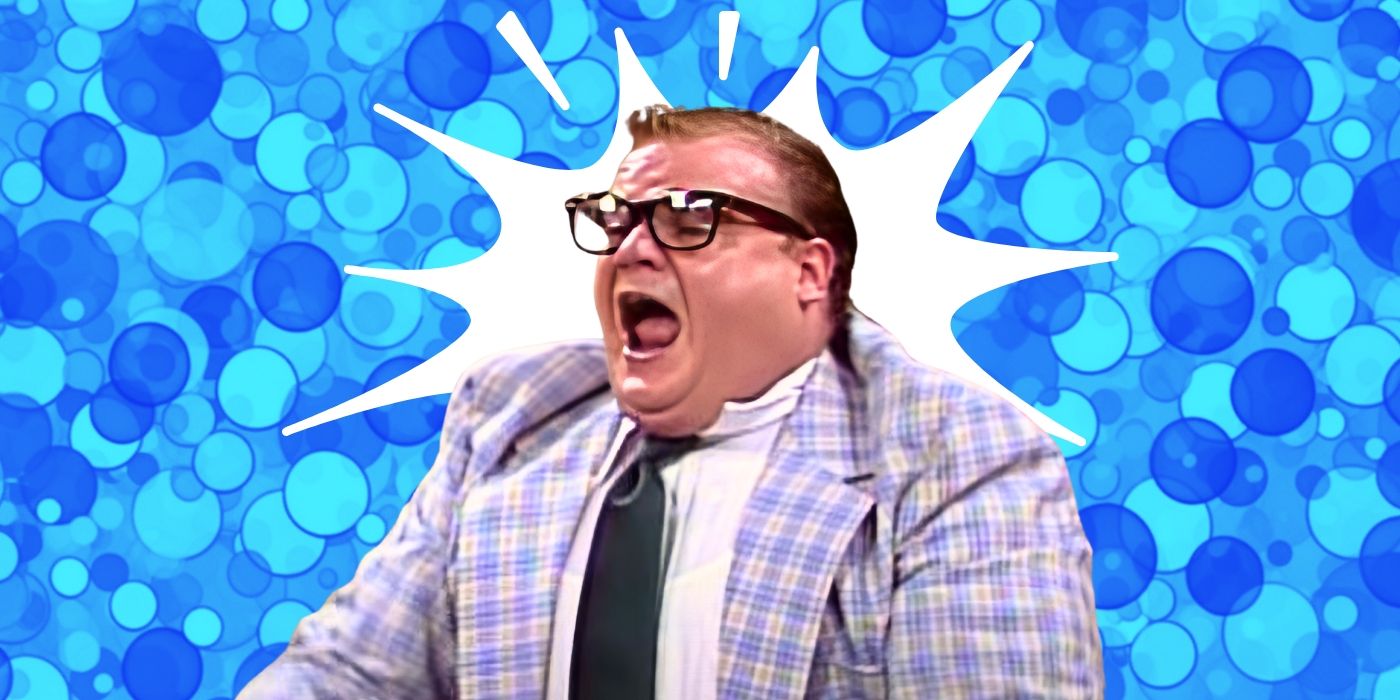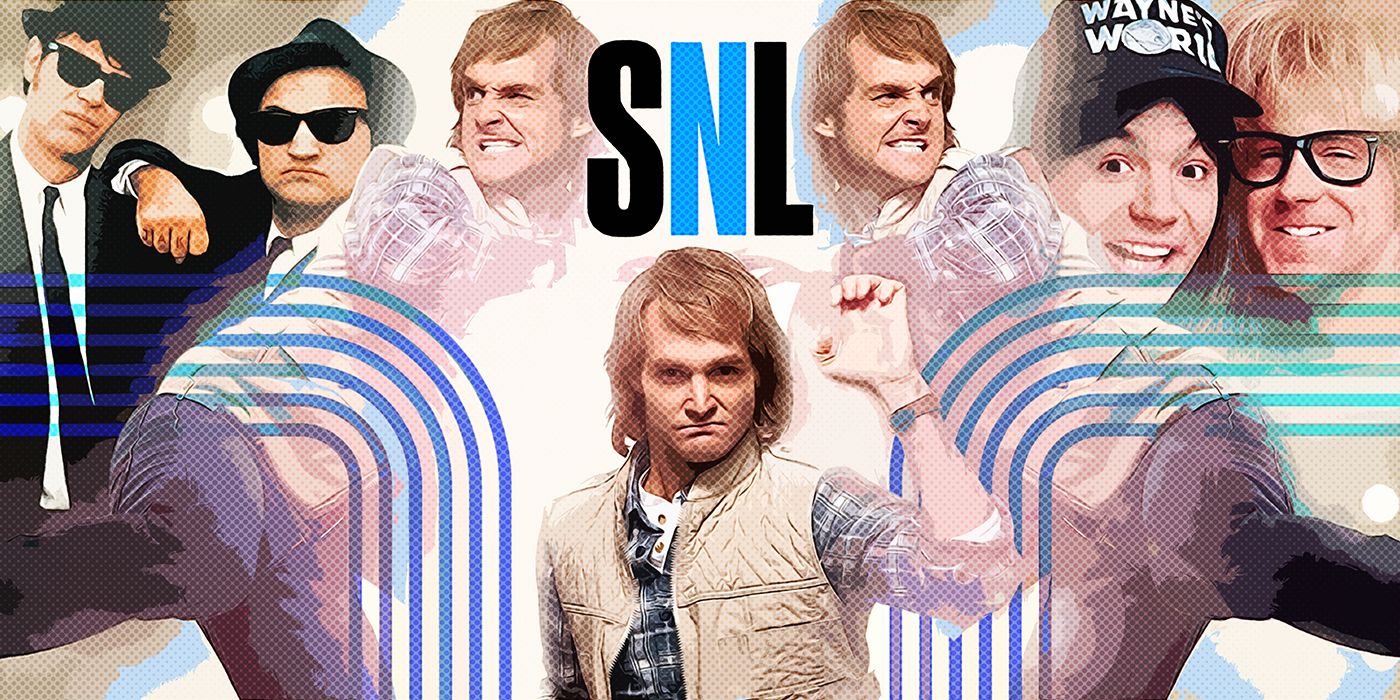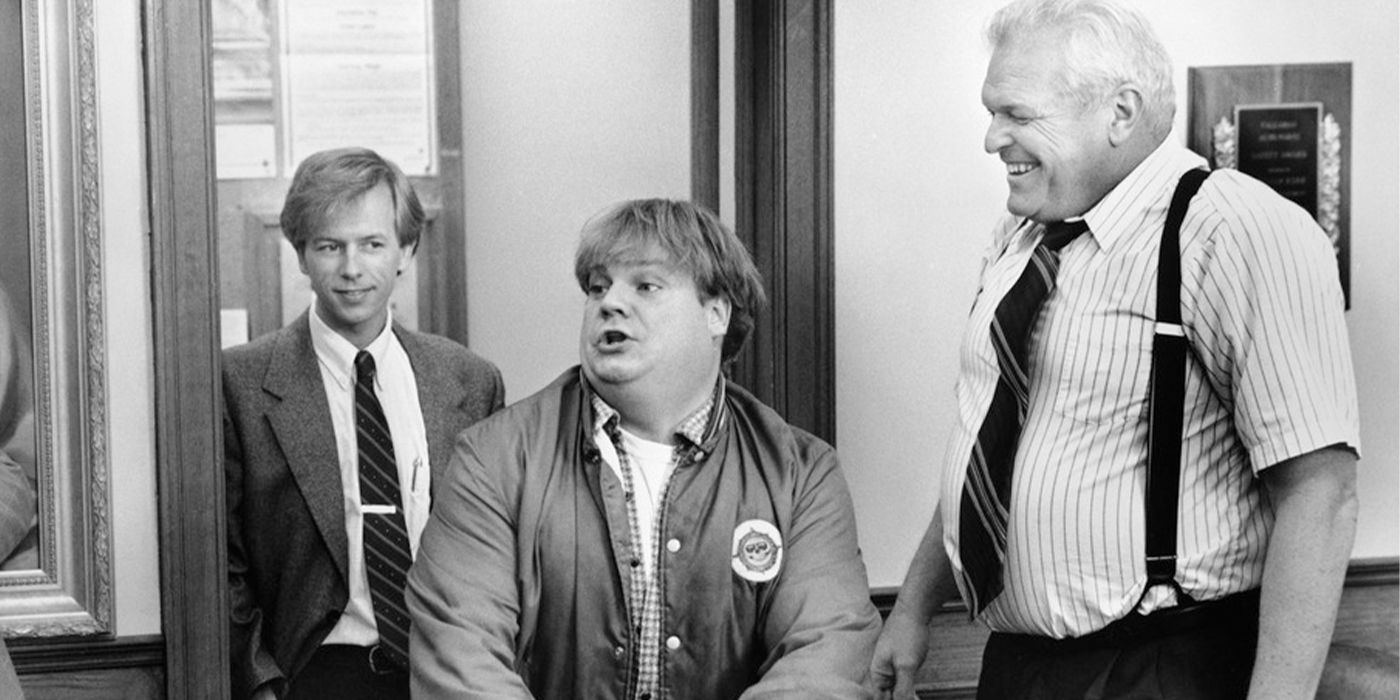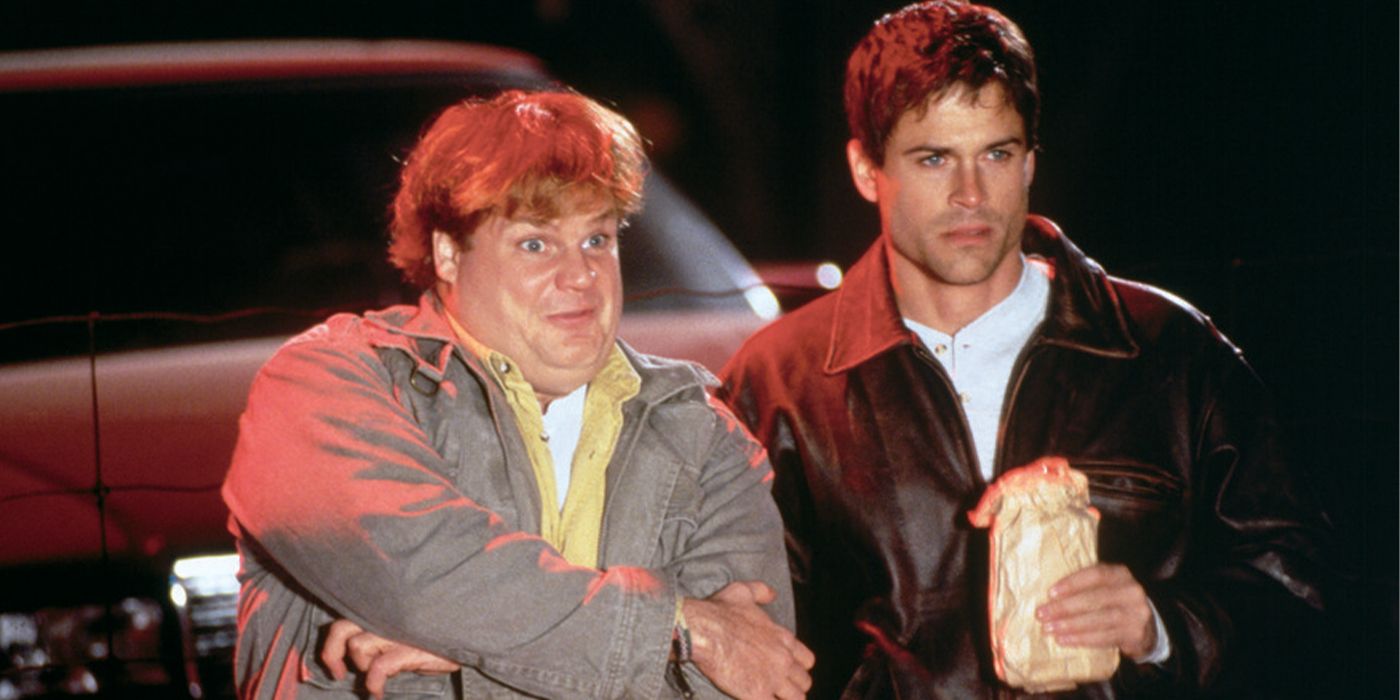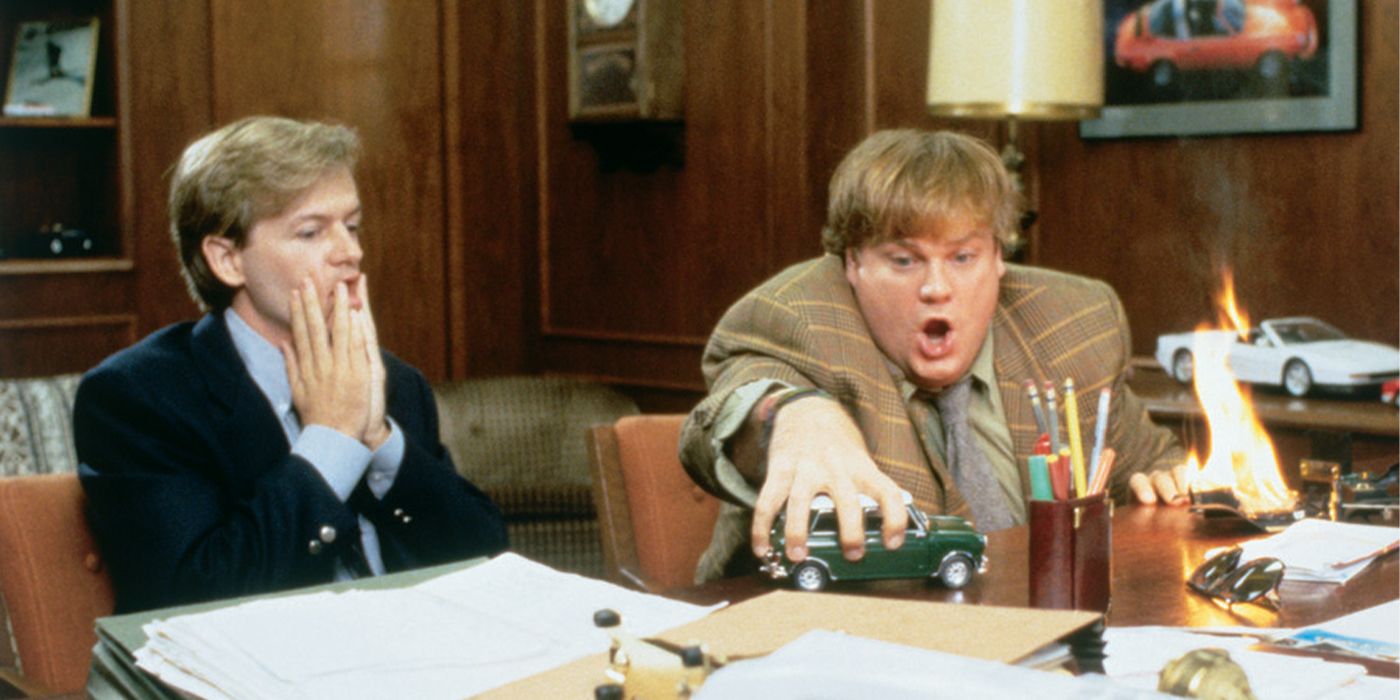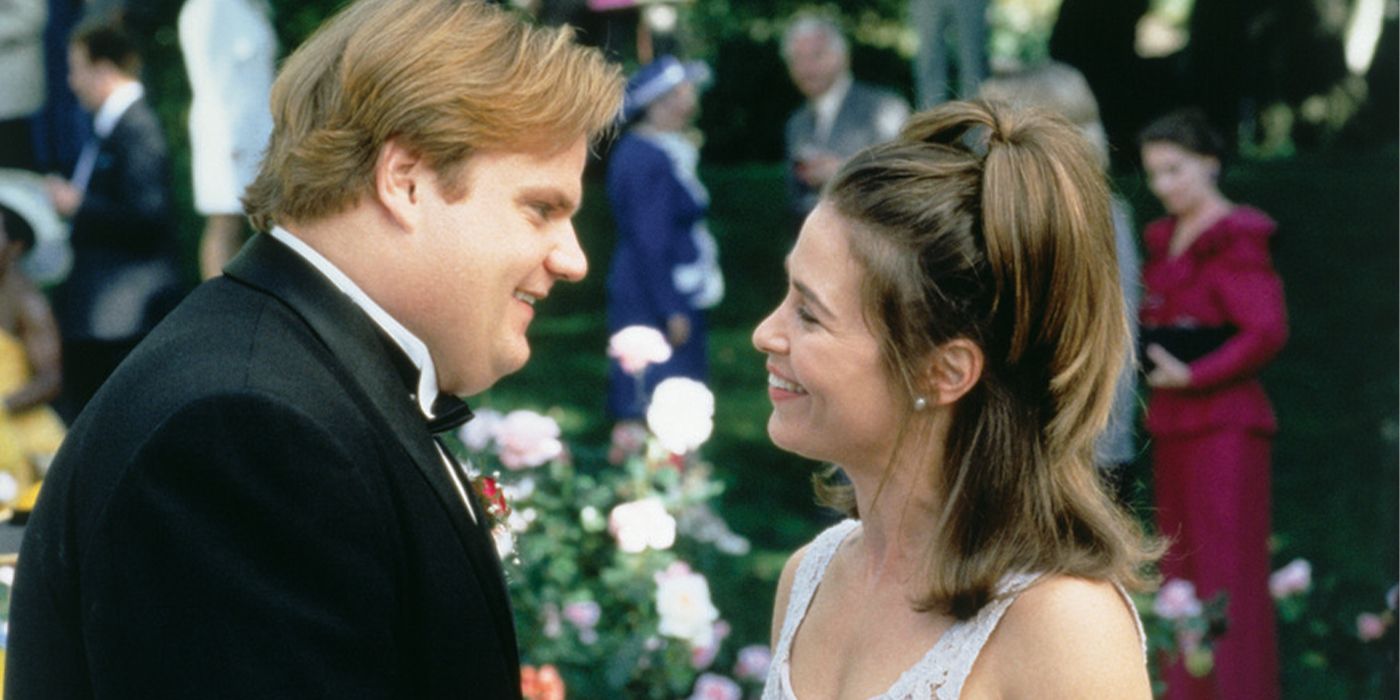Summary
- Tommy Boy director Peter Segal discusses his decades-spanning career with Collider’s Steve Weintraub following a 30th Anniversary 4K screening.
- Segal shares plenty of stories from the set of Tommy Boy, and what it was like working with Chris Farley and David Spade on the film.
- In addition to stories from the set, Segal also shares details on how some of the film’s iconic scenes were built, filmed, and edited, and what it was like working with Jack Nicholson on Anger Management.
Tommy Boy (1995) is a classic road-trip comedy that pairs the beloved goofiness of Chris Farley with the sarcastic quick wit of David Spade. Directed by Peter Segal, known for his work on crowd-pleasing comedies that stand up to the test of time, like Anger Management and 50 First Dates, the film follows the dim-witted but well-meaning Tommy Callahan (Farley) as he embarks on a chaotic sales trip to save his late father’s auto parts business. Blending slapstick humor with genuine heart, Tommy Boy became a cult favorite, showcasing Farley’s comedic brilliance and Segal’s knack for balancing absurdity with heartfelt storytelling.
Following Collider’s 30th Anniversary 4K screening with Paramount Pictures, Steve Weintraub interviewed the director about his career and some of his experiences with Hollywood acting legends on films outside of Tommy Boy. Segal also discusses the experience of bringing the film to life with its hilarious cast in-depth, sharing plenty of behind-the-scenes knowledge for Tommy Boy fans. Check out the conversation in the video above, or you can read the full transcript below.
Jack Nicholson Was “Really Pissed” on ‘Anger Management’
“Kid, you really steamed my clams.”
COLLIDER: What is it like—it’s a school night, and you have a packed theater to see a movie that you made 30 years ago?
PETER SEGAL: It’s pretty nice. I just have to say a couple of shoutouts – our wonderful editor and my best friend is here, Bill Kerr. This was Bill’s first movie, and we started out in local tv together, and he went on to edit a couple of little movies—Bridesmaids, Superbad, Trainwreck, among others. So, I’m glad he’s here. I want to have one other shoutout. Do you remember who the little flower girl was in the wedding? That’s my daughter—Taylor, please stand up. There she is! Taylor has been working for Lorne Michaels for nine years, so she’s doing okay.
I’ve never heard of Lorne Michaels. Who is that?
SEGAL: No idea.
Okay, let me go backwards. Before we get into Tommy Boy, what do you think would surprise people about being a director in Hollywood?
SEGAL: It’s not easy. Going to leave it right there. That’s a very loaded question.
You don’t have to go further. It’s up to you.
SEGAL: Look, it’s like any job. There are good times and there are not good times, but this is incredibly rare to be able to sit here, not having it be a test screening where you’re sweating bullets, but you kind of know by 30 years after it’s come out, “I think we’re okay.” So, this is a great night. But it’s up and down.
You directed Anger Management with [Adam] Sandler and Jack Nicholson. That was one of Jack’s last roles. What was that actually like for you working with a juggernaut like that?
SEGAL: Well, Jack had a young kid who right now is a young man, and he’s doing quite well as an actor, but he was a Sandler fan, and so I think he encouraged Jack to find a new audience, a younger audience. He wanted to play in a different sandbox. It was really interesting because I could tell that Jack was very nervous to work with Adam, and Adam and I were incredibly nervous to work with Jack, so it kind of made a nice balance.
What surprised you about working with him? Did he always want direction? Was he one of these people who could get it on the first take? Did he want, like, eight takes? What does he like, or what was he like to work with?
SEGAL: First of all, Jack is the kind of guy that, when he walks into the room, all of the oxygen is sucked out of the room, that you could hear a pin drop. But I do remember one time we were shooting right after 9/11 in downtown New York, and Sandler said to me at lunch, “Jack’s really pissed at you. What did you fucking do?” I said, “Oh my god, what did I do?” He goes, “I don’t know, man. He said something to me, like, ‘I’m the world’s greatest actor. You’d think Pete would like to know where I’d like to walk.’” In blocking. So, I said, “Okay, jeez, I will let him find his way on the set.”
So, the next day or a few days later, we were filming on an apartment set that I had designed this whole set. We went to his house, me and David Dorfman, the writer, and he said, “I want to break into…” If you’ve seen Anger Management, he’s his anger management therapist. And he has to really analyze Adam’s character’s life. So he said, “I want to come in like a whirling dervish. I want to go through the kitchen, see what he’s eating in the fridge. I want to go into the living room and see what music he’s listening to. Then I want to go into the bathroom and look at his medicine cabinet and see what pills he’s taking, and then I’ll come back.” So, I designed the set where we could pretty much do a 360 and everything.
After what Adam told me, I said, “I’m just going to let him do whatever he wants.” So we had a rehearsal. We cleared the set, and there’s a long hallway to this door. It’s an apartment in New York, and he comes in, and the scene is four and a half pages. He stands right in front of that door and rocks back and forth for four and a half pages, leaving the entire set empty. I’m looking at Adam, and he says, “Don’t worry, don’t worry, we’ll fix it in post. Don’t worry.” And I said, “No, I took notes anyway,” so I gently suggested to Jack, “Jack, I’m just thinking maybe you might want to explore the kitchen and then look through the fridge and maybe explore the living room and look through his music,” basically repeating what he told me.
He ended up doing it, but it happened to be his 65th birthday, and he was not in a good mood. I saw he was in his chair, pissed, and so I went up to him and I said, “Jack, what’s the matter?” He said, “Kid, you really steamed my clams.” I said, “What? What did I do?” He said, “You’re pushing me all over the place.” I got my script with all the notes that I wrote on the back at his house, and I said, “Jack, I’m just doing it. These are your notes. Exactly what you said. Go to here, go to here, go to here, all the way back again. This is what you said.” He looked at it and went, “You’re right. I did say that. Okay.”
That’s great. You directed Naked Gun 33 1⁄3: The Final Insult. What do you remember about filming that and working with Leslie [Nielsen]?
SEGAL: That was a dream come true. David Zucker gave me my first break, and it was fantastic. The ironic thing about the end of Naked Gun and the beginning of Tommy Boy is, I’d worked with Chris [Farley] twice before Tommy Boy—on an HBO special, and then an episode of The Jackie Thomas Show, which was a sitcom on ABC. So, I took the first thing that was offered to me, which was this movie with him in it. We started six weeks after Naked Gun. So, I’m in the pre-production office for Tommy Boy, and my assistant at the time had the TV on the news, and he said, “Pete, isn’t that O.J. [Simpson] getting arrested by a tree?” I looked up, and I was like, “That’s a mistake. They’ll figure that out.” This was six weeks after the premiere, and at the premiere, I sat next to Nicole [Brown]. True story.
That’s crazy. I’m just going to move on, there’s nothing I can follow that with, really.
Why We Never Got That Get Smart Sequel
“Pretty much my whole career is ‘okay.'”
Get Smart made, like, $230 million worldwide. Did anyone ever talk about doing a sequel to that one? I read that the budget was, like, $80-ish, so $230 is like a multiplier of three. It’s there where people could be talking about it.
SEGAL: It’s one of those things: regime changes at studios happen, and the head of the studio had left—he was let go—and this was his baby. So, Alan Horn, who I adore, and was the big champion of the movie, once he left and eventually wound up at Disney and really did an amazing job over there, that was it. No one really wanted to pick up his child and tend to it. So it just went away.
I’ve been fortunate to talk to Alan Horn before, and that guy just knows what he’s doing.
SEGAL: He’s great, I love him.
50 First Dates, another one of your films, that one got “okay” reviews.
SEGAL: Pretty much my whole career is “okay.”
It got okay reviews, but it’s one of those films that people, pardon my language, fucking love. It’s one of those that has stood the test of time. Talk a little bit about making that, and at what point did you realize, “Wait a minute, people really liked this movie?”
SEGAL: You don’t really know how people feel about a movie until a few years after it comes out. You’ll get the immediate response, “Oh, congrats,” “Hey, that’s great,” “It was number one,” or whatever. But you don’t really know until, well, here’s a good example tonight. Obviously, this movie has stuck, but it started where I would bump into marriage counselors just in conversation at a party or whatever. About three different times, marriage counselors said, “We use your movie as a tool for counseling couples and telling them how you have to work at it every day, that every day you have to be like Henry Roth (Adam Sandler) and start over again, or at least say ‘I love you’ and make an attempt, make an effort.” I thought, “Well, that’s interesting.” So, more and more like that, I started to hear things similar. As far as rom-coms go, I just saw Adam was on The Drew Barrymore Show, and they were talking about it. [50 First Dates] and Tommy Boy are two of the ones that really sort of have stuck.
Reflecting on Tommy Boy‘s Earliest Days Versus Tommy Boy Now
“I saw an opportunity for it to be more about two guys who didn’t get along at work.”
Jumping into Tommy Boy. So, it has been 30 years. When you were making the film and when it was coming out, what was the goal in terms of the studio. What were they hoping for? Were they hoping for it to do “okay?” What were their expectations versus the reality?
SEGAL: What I heard from Spade was that Lorne looked at him and Farley goofing around in the writers room at Saturday Night Live and said, “You two need to do a movie.” So he assigned the head writers, Terry and Bonnie Turner, who did the first draft, and they gave it to me. Look, I think it was just a programmer. I mean, Sherry would sometimes see a poster and say, “It’s on the schedule. Spring!” And it was like, “Well, there’s no script yet.” And she was like, “I don’t care.” She was very intuitive.
We should say Sherry Lansig.
SEGAL: Sherry Lansing, the head of Paramount Pictures. I just thought they saw it as a programmer. I think the budget for the music was nonexistent—they thought it was going to be like a garage band. But then we started scoring it with orchestral music, and it sort of changed everything. It took on a different feel.
I remember when she saw the first screening, she said, “Okay, my office. Now.” We walked through a back entrance from the screening room, and she said, “That’s not the movie I bought.” But she had tears in her eyes. “That is not what I expected. That was way better. Where did that heart come from?” I said, “Well, yeah, that’s what we were talking about when we threw the original script out because I had a different idea of the kind of story I wanted it to be.” Originally, it was much more about Tommy and the Rob Lowe character as stepbrothers, with Richard involved, but it was a completely different story. I saw an opportunity for it to be more about two guys who didn’t get along at work, having to work together to save a company and a town. But also, it became a story about a father and son, since Chris had a very close relationship with his own father, which I thought was important.
Throwing out the script caused absolute havoc. We lost our window to shoot between SNL seasons, so we had to film during SNL, which was tough for Chris and Dave. Our $12 million budget jumped to $15 million because we only had them three days a week—the other two, they were flying back to New York. That made everything really difficult.
So I watched it in 4K and it looked amazing. What was it like for you tonight watching it in 4K with everyone?
SEGAL: It was cool. A couple of months ago, Paramount asked me, “Hey, would you like to come in and do another color timing for the movie?” I said, “What are you talking about? Are we doing it in 4K?” I forgot to tell Bill because I didn’t realize—he was like, “Hey, why didn’t you have me come too?” Later, I called him and said, “Dude, I’m still working on this movie 30 years later. It won’t stop.”
What happened was, as I went through the process, I started noticing certain things—some of which were fixed. Since it’s now sharper than the original 35mm, I started seeing details I hadn’t before, like cables. In the prehistoric forest scene, when the car comes to a stop, I suddenly noticed them and thought, “Ooh, I see that.” I spotted a few other things here and there as well. The process revealed some flaws, but it also gave me a chance to go back and fix a couple of little things that had been bugging me for 30 years. I won’t bore you with the details, but it was satisfying to finally tweak them.
But you really need to say what one of them was.
SEGAL: A little piece of hair was in front of David’s forehead, like a stray hair. I finally said, “Guys, could you please paint that loose strand of hair out?” And they said, “Yeah, sure.” And I’m like, “Thank you!” It’s dumb, but it meant something to me.
Have you told David that you did this?
SEGAL: Absolutely not. Please don’t repeat that.
Some of Chris Farley and David Spade’s Iconic Moments Were Unscripted
“Hey, David, does this suit make me look fat?”
What is it like when doing comedy on set versus the script? I’m so curious, as someone who’s directed so much comedy, what is it like when you are directing comedians like this and finding new things on set versus what you have scripted? Because the biggest challenge is time.
SEGAL: The interesting thing here is that Chris and Dave were mostly live performers. They hadn’t done a lot of movies. They hadn’t done any movies as leads. And so, I think in the beginning, there was a lot of boredom, like I was saying earlier, that they were having to do multiple takes with multiple angles. I think there was a little frustration towards me, because they were blaming me for the process of moviemaking. I’m like, “Dude, this is just how it goes.” But because we didn’t have a completed screenplay, I would just scavenge and try to find material in their banter.
One famous story is Chris came out of the wardrobe trailer for his wardrobe test, and he had the now-iconic brown tweed sports coat on, and he said, “Hey, David, does this suit make me look fat?” And David said, “No, your face does,” and I said, “That’s going in.” “Fat Guy in a Little Coat” was a bit that Farley did at the SNL office, but it was only spoken because of the boredom factor.
Here’s a little-known story, although now, I guess more people know about it. We were shooting the scene in “Fat Guy in a Little Coat,” and I shot Chris’s side first. Okay, great. Then I turned around on David and was focusing on him. We only had one camera—we were low-budget—and then, the next day, Bill Kerr calls me and says, “Oh my god, that was hilarious.” I said, “Cool, great.” He goes, “No, no, the singing part off-camera.” I said, “What are you talking about?” “Well, when Farley was off-camera when you were shooting Spade, he started to sing ‘Fat Guy in a Little Coat.’ “You gotta go back and reshoot that. You gotta get that on camera.” So, thank Bill Kerr for that.
One of the things you mentioned was that they were filming SNL while you were filming this, so you could only film for three days. I could be wrong, but it does sound like you didn’t have a completed script. Was it almost beneficial that you were only shooting three days because when they would go back to SNL, you could work on the script?
SEGAL: 100%. That’s exactly it. It was a blessing and a curse going into the SNL season. It pissed those guys off because it was so exhausting, but for me, it was a chance for me and Fred Wolf, who then became the head writer after the Turners left because they sold another show somewhere else, Fred and I would jam. There were times when, for example, it would go down to the wire, the day of, hosing them off after cow tipping.
We were setting up the shot during the day, towards the end of the day, because it was a night shoot, and I was looking at this and saying, “This is not popping. Something’s wrong.” So I called Fred, and Lorne had sort of allowed him to be a utility player and not do as much SNL while we were shooting. I said, “Fred, this scene’s kind of dead.” And he goes, “Well, describe the shot.” I said, “It’s going to be nighttime, Rob’s going to be spraying him with water, it’ll be backlit. So, splashing.” He goes, “Flashdance.” I’m like, “Got it. Thank you. That’s all I needed to hear.” I went up to Chris and I said, “Okay, Chris, when the water hits, you do your best Jennifer Beals.” That’s how we were coming up with stuff, just every day, on the fly.
It’s so crazy because, nine out of 10 times, this might not work, except you had Chris Farley.
SEGAL: Actually, I have to tell you, Farley is amazing, but if you don’t have Spade, you don’t get the same Farley, because Spade is really the comedy engine. He would pitch stuff at Farley, and Farley would whack it out of the park. You needed that pitch, though.
100%. I’m not discounting Spade’s involvement.
SEGAL: I’m saying this, also, because I’m going on his podcast tomorrow. So, he was fantastic!
The Iconic Car of Tommy Boy
“Literally, the title says I bought the car from David Spade.”
Why Toronto?
SEGAL: Money.
Was there a tax break even back then?
SEGAL: Yeah, it was cheaper. The cool thing is, the city of Sandusky’s Chamber of Commerce called me five years ago for the 25th, and they wanted to do a big celebration in Sandusky for the movie, but it got shut down because of the pandemic. So now it’s happening in August. Now it’s going to be the 30th, and it’s a three-day festival. It’s like a car show—the Tommy Boy car will be there, and a beer festival, and screening, and everything. I said to these guys, “It’s fantastic, but you do know we didn’t shoot one frame in Sandusky? We shot it in Toronto.” They said, “We don’t care. There’s two things in Ohio that we have near us: Cedar Point and Tommy Boy. You guys put us on the fucking map.”
Speaking of the Tommy Boy car, you now own one of them. Talk a little bit about the cars themselves and the fact that no one really thought to save one. Let’s get into this.
SEGAL: So, there were four cars. Normally, when you do anything with stunts, you need two because the first may break down or something may go wrong. Then we needed one pristine car, which was only going to be in the first act because there were stages of destruction throughout. Then, as I found out while planning the deer sequence, we had to donate the fourth car to the deer wrangler.
For the deer sequence, I had all these storyboards showing how the destruction was going to go. When I met the animal wrangler, he paged through them, saying, “Nope, nope, nope.” Finally, on the last page—where the deer was on top of the car and then jumped off—he said, “That one we can do.”
I asked, “What will it take to do one shot? Will I need a car for the entire shoot?” He said, “It’s going to take weeks. I’ll put it in the middle of my field, hide your cameras and lights in bushes, and put a ramp on the back of the car. The deer can’t be trained, so it’ll walk up the ramp whenever it wants, eat the food we leave there, then piss and shit. Then one night, when it’s eating—and hopefully not pissing and shitting in the shot—we’ll turn on the lights and camera. That’ll scare it, it’ll jump off the car, and run away.” That was one of the cars. Afterward, they asked if I wanted to buy any of them. At the time, we hadn’t finished the movie or started editing, and I thought, “Hell no. This movie’s going to bomb. I don’t want any memory of it. Keep the cars.”
Well, history turned out differently. A few years later, I started calling around, asking, “Anyone know where those cars went?” “Nope. Nope. Nope.” It wasn’t until five years ago, when I was back in Toronto for the first time since Tommy Boy making My Spy with Dave Bautista, that I found out more. Twelve people on the crew had worked on Tommy Boy 24 years earlier, including the deer wrangler and the transportation coordinator. I asked if they knew where the car went. Nope. Then, one day, I got a call from Bill Kerr. “Dude, the car has been found! It was a barn find. It’s at the Barrett-Jackson auction in Florida. You gotta bid on it.” I knew it was going to be expensive, so I called Spade and offered it to him first. It just felt like the right thing to do. Spade bid on it and won. I asked, “What are you going to do with it?” He said, “Nothing. It’s just a good conversation piece. People can look at it, rusty and destroyed as it is.”
Two years later, I was filming Heels in Atlanta when Spade called me. “I fucked up,” he said. “What? What happened?” “Well, Barrett-Jackson called me. I have this other Chevelle SS going up for auction. Michael Strahan wants it. It ended up selling for some crazy amount. Then they asked if I wanted to flip the GT—the Tommy Boy car—and I said yes. I should have just sold it to you.” I said, “Okay, well…” He said, “You should bid on it, Pete. It’s now at the Scottsdale Barrett-Jackson auction.” So I bid on it, and I got it. Literally, the title says I bought the car from David Spade. But I decided to restore it. It’s been two and a half years, and it might finally be done in two months. Then, we’re taking it to Sandusky.
I have to ask, what does it cost to restore a car?
SEGAL: I am not answering that question.
Is it because your wife is in the audience?
SEGAL: Oh, she knows. That’s why I’m not going to bring it up again. It’s one more reminder. It’s not going well. Thanks. Shh.
I’m glad you’re doing it, though.
SEGAL: Well, thank you.
Peter Segal Reveals Filmmaking Tricks From 30 Years Ago
“First of all, I can’t train a deer.”
Let’s talk about the deer, though. At what point of the shoot did you say to yourself, “Why the F did I choose a deer?”
SEGAL: Oh, I’ll tell you. There was a time when Fred Wolf, the writer, and Lorne Michaels came out from New York because they said, “Pete, Fred’s got a good idea. He wants to pitch it to you.” So, we went to The Ivy on Robertson, and he pitched me the story, and it was based on a true 911 call. Some guy had hit a deer, and he was calling 911 from a payphone while the deer was biting him. You hear the 911 operator trying so hard not to laugh hysterically while this deer was attacking this guy as he’s screaming, “I got a motherfucking deer biting my motherfucking neck!”
Fred said, “We’re going to hit the deer, and it’s going to wake up,” and all this, and I just didn’t get it. I will admit I was going, “That’s mean. We’re going to lose half the audience. This is…” And then Lorne just goes, “Pete, It’s going to work. It’s going to be good.” Then I got on board.
But then planning it, like I said, first of all, I can’t train a deer. So, I got one shot. How did we do the rest? I go into the special effects office, and I said, “Do we have any money to build an animatronic deer?” “Sure we do!” Until weeks later, I go in, and I see the worst robot, and I said, “Oh, that’s horrible. That’s not going to work.” The animatronic deer, I think, has one shot in the movie. The legs of the deer going across the road, that was a goat, and it was a female, so it had an udder full of milk, so we had to duct tape it up so you couldn’t see that.
Then, how do we shoot the destruction? Well, we had nothing left except a deer skin and some antlers. So, it was a grip who just got under it and just [mimes moving around], and that’s how we put that together.
It’s so funny because you don’t think about how 30 years ago, when you were making this, there was no internet. The movie has payphones in—what are those? No CGI. It’s just pretty crazy how far technology has come in those 30 years.
SEGAL: Yeah, you said it. But one little thing towards the end: you know how the boat bonks them on the head—beautiful moment—and then it turns and goes away? Well, even in those days, it was a pretty ingenious thing that our special effects department did. They put a cable on the boat, they put a pulley in the middle of the lake, and that cable ran to that pulley and then that pulley ran to the side, was attached to the hitch of the truck, and it drove away. This Rube Goldbergian thing made this little 10-foot sailboat do its thing. That was pretty cool. And that was so low-tech back then.
But that’s how you made movies back then. I’m so curious about the editing process. When you had a cut you were happy with, what was it like in terms of a friends and family screening or test screening? Do you remember? And did you know at that moment, “Oh, wait, this is pretty funny?”
SEGAL: You don’t know. This was only my second movie, and you get it to a point. You and the editor work together to make it as tight as you think, but then you just don’t know for sure until you put it in front of an audience. What I learned from the Zucker Brothers, who learned it from the Marx Brothers, is that they would take their material and perform it in dinner theaters before bringing it to the stage, testing it to see what worked and what didn’t. What David took from that was his own version of testing: recording the audience to hear the laughter. So if I say, “I got a pretty good laugh,” and Bill says, “I got a titter, barely,” we’d just go to the tape, so we wouldn’t have to argue. I remember I had just gotten a gift—a Sony Handycam—for Christmas, and it had night vision. I said, “Ooh, I have an idea. Let’s put it up here, facing the crowd.” That way, we could not only hear the audio, but also see the crowd, whether they were bored, checking their watch, yawning, fidgeting, all of it. It was the first movie ever to use night vision. Now, it’s an industry standard.
So what was it like, watching the crowd? What did you learn from those early screenings? I know the film has deleted scenes, and obviously, you had multiple takes on certain stuff. So what was it like seeing what the crowd was doing and then figuring out what take you wanted to use?
SEGAL: I’m a nerd when it comes to the testing process. I love the process. Bill and I have done a bunch of stuff together, and we love to just geek out on every aspect of every card that someone writes, something that is either offensive or they didn’t understand. Now, we’ve got this fantastic tool of night vision, and so we had all these tools to help us tighten and eliminate certain things, and explain with if we needed to with ADR, extra dialogue on the back of someone’s head, and we got it to the point where it is. Although, Bill, there are still some things I’d like to tighten up. We’ll talk later.
I didn’t watch the extras, but the 4K has a lot of deleted scenes, alt takes, a commentary by you—a whole bunch of things. What are you most excited for people to see on the 4K release? Is there anything new on it that hasn’t been out previously?
SEGAL: This is primarily the visual quality of the movie. This is the best that it’s ever been. On the 20th, we had a screening at Tarantino’s theater, The New Beverly, and he had the most spectacular 35 millimeter print. It was better than the studio gave USC when I was doing a screening down there. It was spectacular, but this looks even better than that. So, I think that’s the biggest thing that you’re going to see as a difference on this DVD.
What was it actually like in terms of the shooting schedule? You mentioned you had $12 million, then it went to $15. How much time did you actually have to make this?
SEGAL: I think, because of only shooting three days a week, it ended up taking longer. I think it was in the 40s of days. Something like that.
Is that actual shooting days?
SEGAL: Shooting days. There were occasional things that we’d have to do if I didn’t have Chris. I would shoot over a double; certain long shots from driving were doubles. I do remember, because Chris was such a great athlete, he did all of his own stunts. There was nobody who could do stunts better than him that was his size. One shot after the funeral, when Tommy is walking down the lane with all the beautiful fall colors, was a double, and Chris hated it. He said, “That’s not how I walk.” I learned from that one moment. I said, “Okay, I’m not going to do that anymore. It’s all you. So we’re just going to have to wait until you come back.” We just had to sit there, and the studio had no choice, so they went with it.
Chris Farley Saved ‘Tommy Boy’
“Our only victory will be a successful movie.”
One of the scenes in the film that I’m just fucking blown away by is when he’s in the plane bathroom and he has to change, because it’s obviously him doing all this. Talk a little bit about filming that sequence and what he went through, because he beat himself up.
SEGAL: Well, that’s one of the only scenes from the original script—maybe two others, but that was it. I remember my agent saying, “Why did you take this movie?” I said, “Oh, there’s the airplane bathroom scene. That’s pretty funny.” But when you have a set that small, oftentimes you carry it with you. If it’s raining, you go, “Okay, well, bring out the bathroom set.” If you have a little extra time, “Bring out the bathroom set.” So it’s always being trailered around to all of the locations, that stupid bathroom set.
What that did is that built up all this extra anticipation and expectation, because it was the only funny scene in the original script. Everyone was looking forward to that. We kept procrastinating when, when, when, and then finally we set it up. The hard thing is also, how do you film something like that? The bathroom is almost the size of this table. And so, we had a couple of camera portals and did it from up top. The rest was Chris, and then brilliant editing, bringing that all together.
That was all one day?
SEGAL: Oh yeah. That took him, I don’t know, a couple of hours.
That’s so crazy because there are things hitting him. I don’t know how he did it. I really don’t.
SEGAL: Well, we helped key the diaper changing table. That was one. We knew what was going to be destroyed. There was a little extra destruction on the day because Chris is Chris, and he was a big fella. But, yeah, two hours.
When you think back on the making of this film, now looking back 30 years later, what’s a day or two that you always remember, or is it more just you had a blast making this?
SEGAL: I honestly did not have a blast making this because it was so hard.
That’s a real honest answer.
SEGAL: Very honest. I tried to quit the movie early on, and I was strongly encouraged by the head of the studio to stay at it, to not leave if I wanted to keep my home. No joke. So, I was pretty miserable. I would go into Bill’s edit room, and I would cry because my daughters were—my son wasn’t born yet—three and one, and when they did visit, they’d groan. I just felt like, “Oh my god, I’m missing out on life.”
But there was one moment when we were working on the script, and I think we had just written the carpenters scene, which was an idea from Spade, and I got in the car with Chris because we went to go meet Brian Dennehy for dinner, to talk him into doing this. This was a time, you have to remember, when SNL was not doing well. The ratings were in the toilet, and they had arguably one of the best casts in history. It wasn’t just Farley and Spade, it was Sandler and Chris Rock and Mike Myers and others. But the ratings were not good. So, here was this movie that was going out with original characters; it wasn’t based on a Coneheads sketch or a Wayne’s World sketch. It was original. And Chris looked at me in the car, and he said, “Pete, everyone expects us to fail. Our only victory will be a successful movie.” And I looked at him and I just realized, “Alright, we’re in this together.” That was sort of his Band of Brothers moment, and so I’ll never forget that.
Related
‘Saturday Night Live’ Films Ranked, From ‘The Blues Brothers’ to ‘MacGruber’
Live from New York, it’s the best ‘Saturday Night Live’ movies!
‘Tommy Boy’ Director Shares Behind-the-Scenes Stories
“Chris, go run around the courtyard twice, come back, and then drop and give me 20.”
One of the things in this movie that you can never repeat again is when they dress up as flight attendants and just managed to…
SEGAL: Yes, I know the word. You cannot say that. I cringe now hearing it.
It’s crazy. People who weren’t around before 9/11, you could go to the airport and go to the gate. There were things you just could do that 9/11 and –
SEGAL: Oh, that part. I was talking about the R-word.
That too, yeah.
SEGAL: Even back then, I don’t think you could just mug a flight attendant, steal their clothes, and just walk on the plane.
Not at all. It captures a time and place that, even though it’s 30 years old, so much has changed. Talk a little bit about the way moviemaking has changed. This is all shot on film. Another thing is you had a—I forgot how good the orchestra is—soundtrack that is not what I expected.
SEGAL: Like I said, originally, budgetarily, Sherry Lansig said, “You’ve got a nickel for a garage band.” Then I went out and scored it with James Newton Howard, so we temped with James Newton Howard, and then the movie tested well, and Sherry said, “Okay, you get an orchestra.” So, we went out, and that’s the good news. The bad news is David Newman had three weeks to put it together, so we said, “Just come as close to the temp as possible.”
There were times when Bill and I, in the scoring sessions, would do this symbol to each other, which was handcuffs being put on us, because we were too close to the original that we thought, “We’re going to get arrested. This is like ripping off James Newton Howard.” But we did it in a way that it was legal. But I do remember this: I went in for a meeting a couple of years later in Ivan Reitman’s office, and the first thing he said to me as I walked in was, “Nice score.”
Is it true that Rob Lowe only did the movie because he was friends with Chris Farley?
SEGAL: I don’t really know why Rob did the movie. He didn’t put his name on it. I’ve been doing press this past week because of the 30th, and people ask this all the time, “Why did he not have his name on the movie?” I think because he thought it might have sucked and wanted to distance himself. He was very successful in Wayne’s World, and when he signed on, there was probably just half a script, which is what we started with. He was going, “Oh boy, this is going to be fun.” I think that’s why—I don’t really know.
There’s another scene in the film that I really like, and I want to know how you filmed it. It’s when Chris is playing with the model car, trying to sell brake pads, and then he lights it on fire. Talk a little bit about filming that sequence.
SEGAL: That I give credit to Brad Isaacs, who came in and did a little bit of work on the script. And yeah, that one seems to have lived on in infamy. That poor actor—I don’t remember what his name was—he was reacting to it. He did such an amazing job. His reactions were fantastic. There was supposed to be some destruction in it, and the “oh my god” was a bit that Farley had done, and I said, “Well, we’ve got to find a place for that.” It was much more his joke. I cannot even repeat it here, how graphic it was to get to the cop saying, “Oh my god.” Ours was the PG version of it. Anyway, he said, “Can you make this car flammable? I want to light it on fire.” I’m like, “Okay,” and he follows with, “And how many cars do you have? Because how many takes do I get to destroy these things?” “Not a lot, I think we have two.” He goes, “Okay,” and then the rest is him.
When Chris Farley and David Spade are driving, and they’re crying, I read that Chris couldn’t cry, so he poked himself in the eye to get himself to cry.
SEGAL: That was the earlier boat scene with Julie Warner. He poked himself in the eye there. With the carpenters, we just put some glycerin on his cheeks. But yeah, he would do that.
What is that like? Is it right before you’re going to start filming, he just pokes himself?
SEGAL: He was an unusual cat, but he was very athletic. There were times, because he was clean and sober during this movie, and I worked with him earlier when he wasn’t, and so the fact that he replaced the other substances with caffeine was fine, but he was very amped up. When you’re amped up, it’s sort of the opposite of the emotion when you’re crying, when you need to kind of calm down and really feel something. He was so jittery and awake that I think he felt like he needed to do that.
But there were other times, like at the beginning of the movie when he was at college, and he couldn’t get something right, like, “D+!”, that I treated him kind of like an athlete. I said, “Chris, go run around the courtyard twice, and come back.” Or, “Chris, drop and give me 20.” He loved it because he sort of treated me like a coach. Once I got him to calm down and breathe deeply, then he could perform. So, that’s kind of the way we just worked it.
‘Tommy Boy’s 30-Year Legacy Sees It Soaring Still
“I just want him to know…I will.”
Pardon me for not knowing this, but when it came out, how did it do at the box office?
SEGAL: It was number one opening weekend with about $8 million. It only made about $31, all in. It was not released overseas. But that’s not where it made its money. For the 10th anniversary, they flew crews all over the country to interview the whole cast. They did this whole big promotion—bobblehead dolls, maps, all these things. I said to Paramount, “Wow, you guys are doing a lot for this. What’s the big deal?” They said, “Well, this is a top 10 seller for us.” I said, “I don’t understand what that means.” This is 10 years later. Top 10 what? This year?” And they go, “No, top 10 all-time Paramount home video.” “So you mean with, like, Raiders of the Lost Ark and The Godfather top 10?” “Yes.”
It’s so funny because when you think about the making of this film and everything that went on, and it ended up being so, so popular, it’s an amazing, amazing achievement.
SEGAL: Thank you.
For people who wanted to know, or want to know what Chris Farley was like, you’ve done an amazing job tonight pulling back the curtain, but are there any other stories you want to share or anything else you want people to know?
SEGAL: Well, I was just asked this past week about something which made me think. He wrote on my poster, “Pete, come back to me,” and I just want him to know… I will.
Tommy Boy 4K Ultra HD is available for purchase.
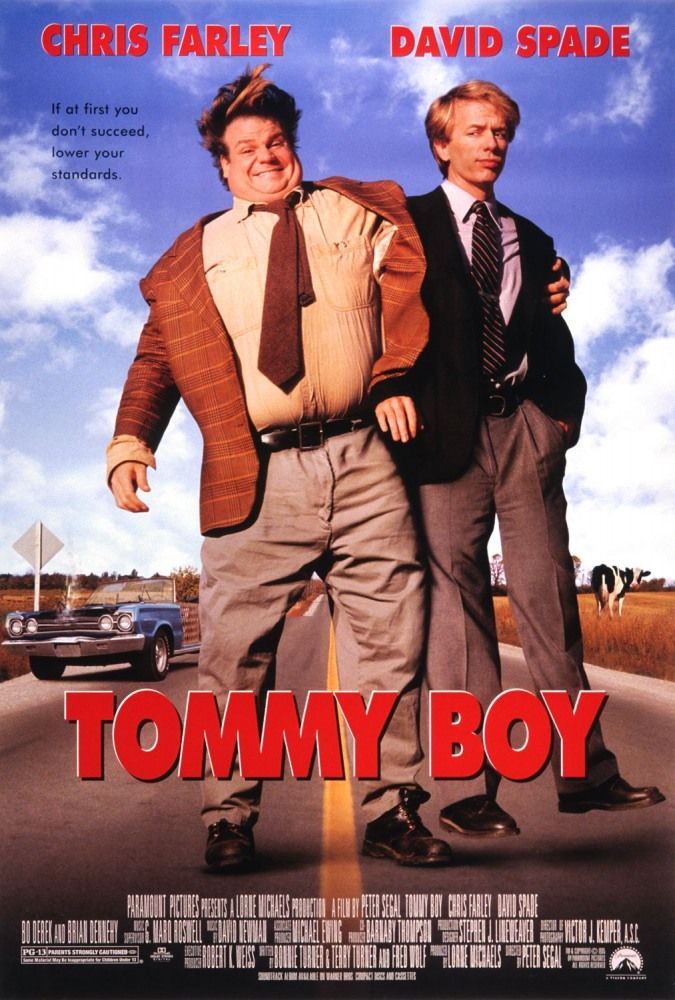

![Chris Farley Saved ‘Tommy Boy’ at a Time When SNL Was Tanking With “One of the Best Casts in History”, Explains Director Pete Segal [Exclusive] Chris Farley Saved ‘Tommy Boy’ at a Time When SNL Was Tanking With “One of the Best Casts in History”, Explains Director Pete Segal [Exclusive]](https://i0.wp.com/static1.colliderimages.com/wordpress/wp-content/uploads/2024/05/anger-management-2003.jpg?w=872&resize=872,547&ssl=1)
![Chris Farley Saved ‘Tommy Boy’ at a Time When SNL Was Tanking With “One of the Best Casts in History”, Explains Director Pete Segal [Exclusive] Chris Farley Saved ‘Tommy Boy’ at a Time When SNL Was Tanking With “One of the Best Casts in History”, Explains Director Pete Segal [Exclusive]](https://static1.colliderimages.com/wordpress/wp-content/uploads/2024/05/anger-management-2003.jpg)
